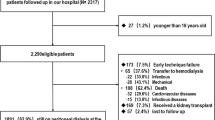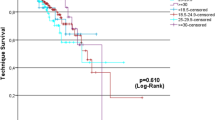Abstract
Purpose
Obesity may negatively impact the clinical outcomes of patients undergoing peritoneal dialysis (PD). However, the impact of obesity on PD-related outcomes remains unclear. We herein examined the association of high body mass index (BMI) with complete hemodialysis (HD) transfer, transition to HD and PD/HD hybrid therapy, peritonitis, catheter exit-site and tunnel infection (ESI/TI), and heart failure-related hospitalization.
Methods
This retrospective cohort study included 120 patients who underwent PD-catheter insertion between January 2008 and June 2018. BMI ≥ 25 kg/m2 at the time of PD-catheter insertion was defined as high BMI, and its association with outcomes was analyzed using the log-rank test and Cox proportional hazards models.
Results
The follow-up duration was 46.2 (23.3–75.3) months. The time until transfer to HD and hybrid therapy was significantly shorter in the high BMI group than that in the low BMI group, whereas the time until HD transfer was not significantly different between the two groups (P < 0.001 and 0.18, respectively). Peritonitis-free and ESI/TI-free survivals were significantly shorter in the high BMI group than those in the low BMI group (P = 0.006 and 0.03, respectively). After adjusting for age, sex, diabetes mellitus, and estimated glomerular filtration rate, high BMI remained a significant risk factor for transferring to HD and hybrid therapy, peritonitis, and ESI/TI (hazard ratio [HR] 2.60, P < 0.001; HR 2.08, P = 0.01; HR 2.64, P = 0.02, respectively).
Conclusion
BMI ≥ 25 kg/m2 is a risk factor for transition to HD and hybrid therapy, peritonitis, and ESI/TI, but not for complete HD transfer in Japanese patients with PD.





Similar content being viewed by others
References
Nitta K, Goto S, Masakane I et al (2020) Annual dialysis data report for 2018, JSDT renal data registry: survey methods, facility data, incidence, prevalence, and mortality. Ren Replace Ther. https://doi.org/10.1186/s41100-020-00286-9
Jaar BG, Plantinga LC, Crews DC et al (2009) Timing, causes, predictors and prognosis of switching from peritoneal dialysis to hemodialysis: a prospective study. BMC Nephrol 10:3. https://doi.org/10.1186/1471-2369-10-3
Guo A, Mujais S (2003) Patient and technique survival on peritoneal dialysis in the United States: evaluation in large incident cohorts. Kidney Int. https://doi.org/10.1046/j.1523-1755.2003.08801.x
Huisman RM, Nieuwenhuizen MG, de Charro Th, F, (2002) Patient-related and centre-related factors influencing technique survival of peritoneal dialysis in the Netherlands. Nephrol Dial Transplant 17:1655–1660. https://doi.org/10.1093/ndt/17.9.1655
Johnson DW, Herzig KA, Purdie DM et al (2000) Is obesity a favorable prognostic factor in peritoneal dialysis patients? Perit Dial Int 20:715–721. https://doi.org/10.1177/089686080002000623
Aslam N, Bernardini J, Fried L, Piraino B (2002) Large body mass index does not predict short-term survival in peritoneal dialysis patients. Perit Dial Int 22:191–196. https://doi.org/10.1177/089686080202200205
McDonald SP, Collins JF, Johnson DW (2003) Obesity is associated with worse peritoneal dialysis outcomes in the Australia and New Zealand patient populations. J Am Soc Nephrol 14:2894–2901. https://doi.org/10.1097/01.asn.0000091587.55159.5f
Snyder JJ, Foley RN, Gilbertson DT, Vonesh EF, Collins AJ (2003) Body size and outcomes on peritoneal dialysis in the United States. Kidney Int 64:1838–1844. https://doi.org/10.1046/j.1523-1755.2003.00287.x
Abbott KC, Glanton CW, Trespalacios FC et al (2004) Body mass index, dialysis modality, and survival: analysis of the United States renal data system dialysis morbidity and mortality wave II study. Kidney Int 65:597–605. https://doi.org/10.1111/j.1523-1755.2004.00385.x
Johansen KL, Young B, Kaysen GA, Chertow GM (2004) Association of body size with outcomes among patients beginning dialysis. Am J Clin Nutr 80:324–332. https://doi.org/10.1093/ajcn/80.2.324
de Mutsert R, Grootendorst DC, Boeschoten EW, Dekker FW, Krediet RT (2009) Is obesity associated with a survival advantage in patients starting peritoneal dialysis? Contrib Nephrol 163:124–131. https://doi.org/10.1159/000223790
Obi Y, Streja E, Mehrotra R, Rivara MB, Rhee CM, Soohoo M et al (2018) Impact of obesity on modality longevity, residual kidney function, peritonitis, and survival among incident peritoneal dialysis patients. Am J Kidney Dis 71:802–813. https://doi.org/10.1053/j.ajkd.2017.09.010
Shibagaki Y, Faber MD, Divine G, Shetty A (2002) Feasibility of adequate solute clearance in obese patients on peritoneal dialysis: a cross-sectional study. Am J Kidney Dis 40:1295–1300. https://doi.org/10.1053/ajkd.2002.36904
Yoshiike NWN, Matsushima S, Ito C et al (2000) Obese degree and diabetes, hypertension based on body mass index, epidemiological examination - by associated - multicenter study with the risk factor of hyperlipidemia. J Japan Soc Study Obes 6:4–17
Kawanishi H, Marshall MR, Zhao J et al (2021) Mortality, hospitalization and transfer to haemodialysis and hybrid therapy, in Japanese peritoneal dialysis patients. Perit Dial Int. https://doi.org/10.1177/08968608211016127
Kang SH, Cho KH, Park JW, Yoon KW, Do JY (2013) Geriatric nutritional risk index as a prognostic factor in peritoneal dialysis patients. Perit Dial Int 33:405–410. https://doi.org/10.3747/pdi.2012.00018
Figueiredo A, Goh BL, Jenkins S et al (2010) Clinical practice guidelines for peritoneal access. Perit Dial Int 30:424–429. https://doi.org/10.3747/pdi.2010.00087
Nakayama M, Miyazaki M, Honda K et al (2014) Encapsulating peritoneal sclerosis in the era of a multi-disciplinary approach based on biocompatible solutions: the NEXT-PD study. Perit Dial Int 34:766–774. https://doi.org/10.3747/pdi.2013.00074
Kolesnyk I, Dekker FW, Boeschoten EW, Krediet RT (2010) Time-dependent reasons for peritoneal dialysis technique failure and mortality. Perit Dial Int 30:170–177. https://doi.org/10.3747/pdi.2008.00277
Chidambaram M, Bargman JM, Quinn RR, Austin PC, Hux JE, Laupacis A (2011) Patient and physician predictors of peritoneal dialysis technique failure: a population based, retrospective cohort study. Perit Dial Int 31:565–573. https://doi.org/10.3747/pdi.2010.00096
See EJ, Johnson DW, Hawley CM et al (2018) Risk predictors and causes of technique failure within the first year of peritoneal dialysis: an Australia and New Zealand dialysis and transplant registry (ANZDATA) study. Am J Kidney Dis 72:188–197. https://doi.org/10.1053/j.ajkd.2017.10.019
Boundville N, Ullah S, Clayton P et al (2019) Differences in peritoneal dialysis technique survival between patients treated with peritoneal dialysis systems from different companies. Nephrol Dial Transplant 34:1035–1044. https://doi.org/10.1093/ndt/gfy340
Cho Y, Johnson DW (2014) Peritoneal dialysis-related peritonitis: towards improving evidence, practices, and outcomes. Am J Kidney Dis 64:278–289. https://doi.org/10.1053/j.ajkd.2014.02.025
Nakayama T, Uchiyama K, Washida N et al (2021) Exercise parameters predict technique survival in patients on peritoneal dialysis. Blood Purif 50:380–389. https://doi.org/10.1159/000511293
Kanda Y (2013) Investigation of the freely available easy-to-use software “EZR” for medical statistics. Bone Marrow Transplant 48:452–458. https://doi.org/10.1038/bmt.2012.244
Isla RA, Mapiye D, Swanepoel CR, Rozumyk N, Hubahib JE, Okpechi IG (2014) Continuous ambulatory peritoneal dialysis in Limpopo province, South Africa: Predictors of patient and technique survival. Perit Dial Int 34:518–525. https://doi.org/10.3747/pdi.2013.00334
Descoeudres B, Koller MT, Garzoni D et al (2008) Contribution of early failure to outcome on peritoneal dialysis. Perit Dial Int 28:259–267. https://doi.org/10.1177/089686080802800312
Cueto-Manzano AM, Quintana-Piña E, Correa-Rotter R (2001) Long-term CAPD survival and analysis of mortality risk factors: 12-year experience of a single Mexican center. Perit Dial Int 21:148–153. https://doi.org/10.1177/089686080102100207
Chen HL, Tarng DC, Huang LH (2019) Risk factors associated with outcomes of peritoneal dialysis in Taiwan: an analysis using a competing risk model. Med (Baltim) 98:e14385. https://doi.org/10.1097/MD.0000000000014385
Shi Y, Zheng D, Zhang L et al (2017) Six-minute walk test predicts all-cause mortality and technique failure in ambulatory peritoneal dialysis patients. Nephrology (Carlton) 22:118–124. https://doi.org/10.1111/nep.12726
Matsui M, Akai Y, Samejima KI et al (2017) Prognostic value of predialysis indices for technique failure and mortality in peritoneal dialysis patients. Ther Apher Dial 21:493–499. https://doi.org/10.1111/1744-9987.12546
Murashima M, Hamano T, Abe M, Masakane I (2021) Combination of once-weekly haemodialysis with peritoneal dialysis is associated with lower mortality compared with peritoneal dialysis alone: a longitudinal study. Clin Kidney J 14:1610–1617. https://doi.org/10.1093/ckj/sfaa173
Tanaka M, Ishibashi Y, Hamasaki Y et al (2020) Bioimpedance spectroscopy-based fluid status in combined dialysis compared with hemodialysis and peritoneal dialysis: a cross-sectional study. Ther Apher Dial 24:373–379. https://doi.org/10.1111/1744-9987.13444
Wang AY (2007) The john F. Maher award recipient Lecture 2006. The “heart” of peritoneal dialysis: residual renal function. Perit Dial Int 27:116–124. https://doi.org/10.1177/089686080702700203
Ozener C, Arikan H, Karayaylali I et al (2014) The impact of diabetes mellitus on peritoneal dialysis: the Turkey multicenter clinic study. Ren Fail 36:149–153. https://doi.org/10.3109/0886022X.2013.843275
Nessim SJ, Bargman JM, Austin PC, Nisenbaum R, Jassal SV (2009) Predictors of peritonitis in patients on peritoneal dialysis: results of a large, prospective Canadian database. Clin J Am Soc Nephrol 4:1195–1200. https://doi.org/10.2215/CJN.00910209
Tsai CC, Lee JJ, Liu TP, Ko WC, Wu CJ, Pan CF et al (2013) Effects of age and diabetes mellitus on clinical outcomes in patients with peritoneal dialysis-related peritonitis. Surg Infect (Larchmt) 14:540–546. https://doi.org/10.1089/sur.2012.195
Conway EL, Sellick JA, Kurtzhalts K, Mergenhagen KA (2017) Obesity and heart failure as predictors of failure in outpatient skin and soft tissue infections. Antimicrobial Agents Chemother. https://doi.org/10.1128/AAC.02389-16
Falagas ME, Kompoti M (2006) Obesity and infection. Lancet Infect Dis 6:438–446. https://doi.org/10.1016/S1473-3099(06)70523-0
Long C, Bartlett G, Macgibbon B et al (2013) The effect of obesity on antibiotic treatment failure: a historical cohort study. Pharmacoepidemiol Drug Saf 22:970–976. https://doi.org/10.1002/pds.3461
Gallagher D, Heymsfield SB, Heo M, Jebb SA, Murgatroyd PR, Sakamoto Y (2000) Healthy percentage body fat ranges: an approach for developing guidelines based on body mass index. Am J Clin Nutr 72:694–701. https://doi.org/10.1093/ajcn/72.3.694
Alves Junior CA, Mocellin MC, Gonçalves ECA, Silva DA, Trindade EB (2017) Anthropometric indicators as body fat discriminators in children and adolescents: a systematic review and meta-analysis. Adv Nutr 8:718–727. https://doi.org/10.3945/an.117.015446
Funding
None.
Author information
Authors and Affiliations
Contributions
KU designed the study, and EY wrote the initial draft of the manuscript. EY, KU, TN, EK, TN, IY, KM, and NW contributed to data collection. EY and KU contributed to analysis and interpretation of data and assisted in the preparation of the manuscript. KM, NW, and HI supervised the manuscript. All authors have approved the final version of the manuscript and agreed to be accountable for all aspects of the work in ensuring that questions related to the accuracy or integrity of any part of the work are appropriately investigated and resolved.
Corresponding author
Ethics declarations
Conflict of interest
All the authors have no conflicts of interest to declare.
Ethical approval
This study and all its protocols were reviewed and approved by the ethics committee of our hospital, and informed consent was obtained from all patients prior to participation.
Additional information
Publisher's Note
Springer Nature remains neutral with regard to jurisdictional claims in published maps and institutional affiliations.
Supplementary Information
Below is the link to the electronic supplementary material.
Rights and permissions
About this article
Cite this article
Hama, E.Y., Uchiyama, K., Nagasaka, T. et al. High body mass index is a risk factor for transition to hemodialysis or hybrid therapy and peritoneal dialysis-related infection in Japanese patients undergoing peritoneal dialysis. Int Urol Nephrol 54, 3193–3202 (2022). https://doi.org/10.1007/s11255-022-03252-y
Received:
Accepted:
Published:
Issue Date:
DOI: https://doi.org/10.1007/s11255-022-03252-y




